(完整版)PS材料注塑成型工艺的研究毕业设计论文
注塑模设计毕业设计

注塑模设计毕业设计【篇一:注塑模设计毕业论文】毕业设计(论文)题目:茶杯盖注射模具设计作者届别系别机电系专业机械设计及其自动化指导教师职称完成时间摘要塑料在当今世界上无处不用,因此塑料模具有很大发展,特别是注塑模。
由此可知,研究注塑模具对了解塑料产品的生产过程和提高产品质量有很大意义。
本课题主要是针对瓶盖的模具设计,通过对塑件进行工艺性分析和比较,最终设计出一副注塑模。
该课题从产品结构工艺性及具体模具结构出发,对模具的浇注系统、模具成型部分的结构、顶出系统、冷却系统、注塑机的选择及有关参数的校核、都有详细的设计,同时并简单的编制了模具的加工工艺。
通过整个设计过程表明该模具能够达到此塑件所要求的加工工艺。
根据题目设计的主要任务是茶杯盖注塑模具的设计。
也就是设计一副注塑模具来生产茶杯盖的塑件产品,以实现自动化提高产量。
通过本设计,可以对注塑模具有一个较深的认识,注意到设计中的某些细节问题,了解模具结构及工作原理;通过对program的学习,可以建立较简单零件的零件库,从而有效的提高工作效率;通过画装配图、零件图,进一步系统深化cad熟练程度,加深了对模具各个零件的认识。
关键字: 塑料模具,注射机,型腔,浇注系统abstractplastic is everywhere in the world today with , therefore has great development prospects of plastic , especially in injection molding ,so the study of plastic injection molds for understanding the production process and improve the quality of productshave great significance.this topic mainly aims at bottle caps mold design, through to models to carry on the technological analysis and the comparison , this topic embarks from the product mix technology capability and the concrete mold structure , tomolds gating system, the mold formation parts structure, goesagainst the system, the cooling system, injection molding machines choice and the related parameter examination, has the detailed design, simultaneously and simple establishment molds processing craft. through the entire design process indicated that this mold can achieve this to model the processing craft which an institute requests. is the teacup covers injection molds design according to the topic designs primary mission. is also designs an injection mold to produce the teacup to cover models a product, realizes the automation to raise the outputthrough the design, injection mold can have a deeper understanding of the design notes that some of the details to understand the structure and working principle ofmold.through learning program, you can create a simpler components parts store, and effective improve efficiency; through painting assembly drawing, part drawings, and further deepen the cad system proficiency, a better understanding of the various parts of mold.key words: plastic mold, injection machine, mold cavity, pouring system目录1前言 (6)1.1模具工业的地位 (6)1.2塑料注射模具的现状及发展趋势 (6)2茶杯盖制件分析 (9)2.1茶杯盖的模具设计流程 (9)2.2塑件分析 (10)2.3茶杯盖的三维图 (11)3 茶杯盒盖的注塑模具设计 (11)3.1方案的选择 (11)3.2制件成型位置及分型面选择 (12)3.3浇注系统设计 (12)3.3脱模机构设计 (14)3.4 溢料排气系统设计 (14)3.5模具主要零件的结构设计 ....................... (15)3.5.1凹模工作尺寸的计算 (16)3.5.2 凸模工作尺寸的计算 (17)3.5.3 前模仁的设计 (18)3.5.4成型零件的设计 (19)3.6导向与定位机构 (20)3.7 选择脱模方式 (21)3.7.1脱模机构的设计 (21)3.7.2脱模力计算� (21)3.8 侧抽芯机构的设计 (22)3.9.模架选用 (23)4.注射机的选择 (24)4.1 注塑机基本参数 (24)4.2初选注塑机 (25)4.3 注射机的校核 (26)4.3.1 注射压力的校核 (26)4.3.2 锁模力的校核 (26)4.3.3安装部分相关尺寸的校核 (26)4.3.4 模具外形尺寸校核 (27)4.3.5 模具厚度校核 (27)4.3.6模具安装尺寸校核 (27)4.3.7 开模行程校核 (27)5.塑件的总装图 (28)6参考文献 (29)【篇二:毕业设计注塑模具设计】摘要根据注射模具在国内外的飞速发展以及注射模软件cad/cam 的提高再结合我校专业特色及本专业的培养计划,我选用奇瑞车的工具箱盖双型腔注塑模设计作为本次的毕业设计题目。
注塑模毕业设计论文
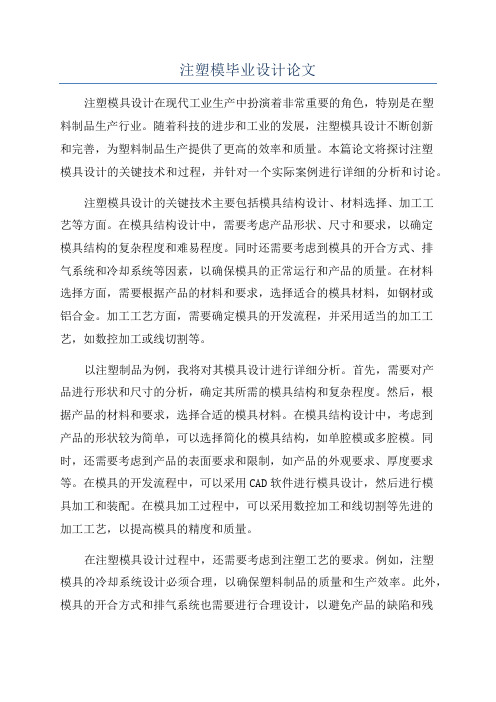
注塑模毕业设计论文注塑模具设计在现代工业生产中扮演着非常重要的角色,特别是在塑料制品生产行业。
随着科技的进步和工业的发展,注塑模具设计不断创新和完善,为塑料制品生产提供了更高的效率和质量。
本篇论文将探讨注塑模具设计的关键技术和过程,并针对一个实际案例进行详细的分析和讨论。
注塑模具设计的关键技术主要包括模具结构设计、材料选择、加工工艺等方面。
在模具结构设计中,需要考虑产品形状、尺寸和要求,以确定模具结构的复杂程度和难易程度。
同时还需要考虑到模具的开合方式、排气系统和冷却系统等因素,以确保模具的正常运行和产品的质量。
在材料选择方面,需要根据产品的材料和要求,选择适合的模具材料,如钢材或铝合金。
加工工艺方面,需要确定模具的开发流程,并采用适当的加工工艺,如数控加工或线切割等。
以注塑制品为例,我将对其模具设计进行详细分析。
首先,需要对产品进行形状和尺寸的分析,确定其所需的模具结构和复杂程度。
然后,根据产品的材料和要求,选择合适的模具材料。
在模具结构设计中,考虑到产品的形状较为简单,可以选择简化的模具结构,如单腔模或多腔模。
同时,还需要考虑到产品的表面要求和限制,如产品的外观要求、厚度要求等。
在模具的开发流程中,可以采用CAD软件进行模具设计,然后进行模具加工和装配。
在模具加工过程中,可以采用数控加工和线切割等先进的加工工艺,以提高模具的精度和质量。
在注塑模具设计过程中,还需要考虑到注塑工艺的要求。
例如,注塑模具的冷却系统设计必须合理,以确保塑料制品的质量和生产效率。
此外,模具的开合方式和排气系统也需要进行合理设计,以避免产品的缺陷和残留物。
同时,还需要进行模具的合理维护和保养,以延长其使用寿命和保证生产质量。
综上所述,注塑模具设计是塑料制品生产中不可或缺的环节。
通过合理的模具设计和加工工艺,可以提高塑料制品的生产效率和质量。
因此,注塑模具设计的研究和创新具有重要的理论和应用价值。
注塑模设计毕业论文

注塑模设计毕业论⽂注塑模设计毕业论⽂ 注塑模设计毕业论⽂该如何写呢?具体有什么内容?以下是⼩编为⼤家整理的有关注塑模设计的论⽂,希望对你有所帮助! 注塑模设计毕业论⽂【1】 摘要 本⽂是关于以汽车底盘零件为研究对象的注塑模设计,通过对其结构形式和材料的注射成型⼯艺进⾏正确的分析,设计了⼀模两腔的塑料注射成型模具。
塑料模毕业设计是模具专业学⽣在学习过程中的⼀个重要实践性学习环节,其⽬的是: 1.应⽤本专业所学的理论知识和实训技能进⾏⼀次注射模设计⼯作的实际训练,以提⾼独⽴分析和解决实际问题的技能、培养从科技研究⼯作的初步能⼒。
2.通过查设计资料⼿册和视频,熟悉设计标准和技术规范,通过进⾏⽅案论证、设计与计算、cad、u绘数据处理和综合分析,编写说明书等环节进⾏⼯程师的基本训练。
3.根据本设计任务书,再通过分析了任务题⽬连接套筒零件的结构和注射⼯艺性的基础上,详细介绍了在u软件平台上快速⽣成连接套筒注射模型腔、型芯的过程。
并介绍了运⽤模具专家系统进⾏模架和其它零部件设计及开模仿真⽅法。
u的应⽤缩短了该模具的开发周期,提⾼了效率,降低了成本。
4.培养勤奋、求实、团结互助、勇于创新的优良品质。
希望通过本次毕业设计答辩,进⼀步巩固、深化、扩⼤所学到的知识、技能。
关键词: 注射模、cad、u、机械。
引⾔ 近年来,模具在产品制造过程中占据重要地位。
模具设计⽔平的⾼低,在很⼤程度上决定了⽣产率的⾼低。
有效的模具设计可以降低资源调整次数和调整时间,为⽣产计划与调度提供更⼤的优化空间,以达到提⾼⽣产效率的⽬的。
模具设计是⼯装系统的重要组成部分,它影响着产品⽣产的效率和质量。
对模具设计进⾏深⼊的研究有着重要意义。
中国塑料模具制造⽔平已有较⼤提⾼。
型塑料模具已能⽣产单套重量达到50t以上的注塑模,精密塑料模具的精度已达到2µm,制件精度很⾼的⼩模数齿轮模具及达到⾼光学要求的车灯模具等也已能⽣产,多腔塑料模具已能⽣产⼀模7800腔的塑封模,⾼速模具⽅⾯已能⽣产挤出速度达6m/min以上的⾼速塑料异型材挤出模具及主型材双腔共挤、双⾊共挤、软硬共挤、后共挤、再⽣料共挤出和低发泡钢塑共挤等各种模具。
(毕业设计论文)塑料注射模具设计
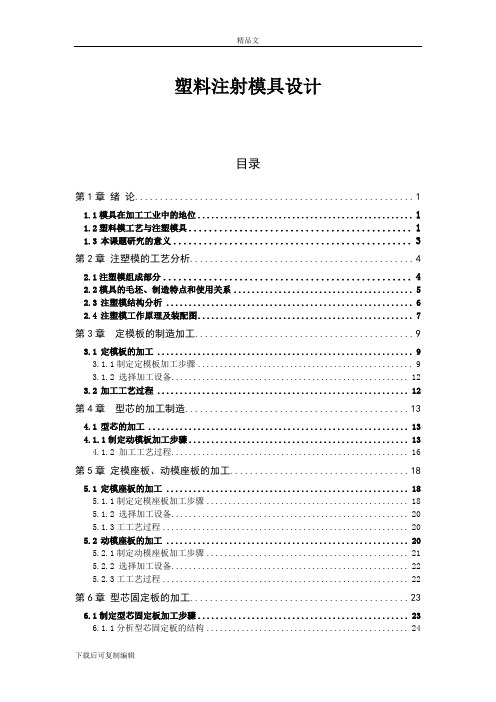
塑料注射模具设计目录第1章绪论 (1)1.1模具在加工工业中的地位 (1)1.2塑料模工艺与注塑模具 (1)1.3本课题研究的意义 (3)第2章注塑模的工艺分析 (4)2.1注塑模组成部分 (4)2.2模具的毛坯、制造特点和使用关系 (5)2.3注塑模结构分析 (6)2.4注塑模工作原理及装配图 (7)第3章定模板的制造加工 (9)3.1定模板的加工 (9)3.1.1制定定模板加工步骤 (9)3.1.2 选择加工设备 (12)3.2加工工艺过程 (12)第4章型芯的加工制造 (13)4.1型芯的加工 (13)4.1.1制定动模板加工步骤 (13)4.1.2 加工工艺过程 (16)第5章定模座板、动模座板的加工 (18)5.1定模座板的加工 (18)5.1.1制定定模座板加工步骤 (18)5.1.2 选择加工设备 (20)5.1.3工工艺过程 (20)5.2动模座板的加工 (20)5.2.1制定动模座板加工步骤 (21)5.2.2 选择加工设备 (22)5.2.3工工艺过程 (22)第6章型芯固定板的加工 (23)6.1制定型芯固定板加工步骤 (23)6.1.1分析型芯固定板的结构 (24)6.1.2 确定加工方法 (24)6.1.3 选择加工设备 (24)6.2加工工艺过程 (24)第7 章支承零部件的加工 (26)7.1支承板的加工 (26)7.1.1制定支承板加工步骤 (26)7.1.2 加工工艺过程 (27)7.2垫块的加工 (28)7.2.1制定垫块加工步骤 (28)7.1.2 加工工艺过程 (29)第8章推出机构的制造 (30)8.1推件板的加工步骤 (30)8.1.1制定推件板加工步骤 (30)8.1.2 加工工艺过程 (34)8.2推板的制造 (34)8.2.1制定推板加工步骤 (35)8.2.2 加工工艺过程 (35)8.3推杆固定板的加工 (36)8.3.1制定动模板加工步骤 (36)8.3.2 加工工艺过程 (37)第9章标准件的选用 (38)9.1导柱的选用 (38)9.2浇口套的选用 (39)第10章模具装配、试模与调试 (41)10.1模具装配工艺过程 (41)10.2连接件的调试与修整 (43)10.3注塑模中出现的问题 (44)10.4成型设备的参数 (44)结论 (46)参考文献 (47)致谢 (48)附录 (49)第1章绪论1.1模具在加工工业中的地位模具是工业生产的重要装备,是国民经济的基础设备,是衡量一个国家和地区工业水平的重要标志。
注塑模具设计毕业设计论文参考模板

1.前言 (3)1.1毕业设计的目的 (3)1.2题目内容及要求 (3)2.塑件的工艺分析 (3)2.1塑件材料的选择 (3)2.2塑件的工艺特性分析 (3)3.注射机的选择与模具结构形式 (3)3. 1 设备的选择与参数校核 (3)3.1.1注射机型号的选择 (3)3.1.2 模具参数的校核 (4)3.2模具结构确定 (4)3.2.1确定型腔数量及排列方式 (4)3.2.2分型面的设计 (5)4.浇注系统设计 (5)4.1浇注系统的组成 (5)4.2主流道设计 (5)4.3分流道设计 (7)4.3.1分流道的形状及尺寸 (7)4.3.2 分流道的长度 (7)4.3.3分流道的粗糙度 (7)4.4浇口的设计 (7)4.5浇注系统的平衡 (7)4.6冷料穴的设计 (7)5.成型零件的设计 (7)5.1注射成型零部件结构设计 (7)5.1.1凹模 (7)5.1.2凸模 (8)5.2成型零部件工作尺寸的计算 (8)5.2.1凹模的径向尺寸的计算 (10)5.2.2 凹模深度尺寸的计算 (11)5.2.3 凸模径向工作尺寸的计算 (11)5.2.4凸模高度工作尺寸的计算 (12)5.3成型零件的加工工艺 (12)6. 注射模导向与推出机构设计 (12)6.1导向机构的设计 (12)6.1.1导柱的结构形式 (12)6.1.2导套 (13)6.2脱模力计算 (13)6.3 推出机构的设计 (14)6.3.1推出机构的组成 (14)6.3.2推杆位置的设定 (14)6.3.3推出机构的导向 (15)6.4复位零件 (15)6.4.1复位杆复位 (16)6.4.2弹簧复位 (16)7.冷却系统的设计 (17)7.1冷却系统的设计 (17)8.1固定板 (18)8.2模脚 (18)8.3支承板与垫块 (18)9.设计总结 (18)致谢............................................................................................... 错误!未定义书签。
(完整版)20塑料注塑模具毕业设计论文

优秀论文审核通过未经允许切勿外传摘要本文是关于外壳塑料件设计,主要内容包括塑件的成形工艺分析,模具结构形式的确定,分型面位置的确定, 浇注系统的形式和浇口的设计 , 成形零件的结构设计和计算 , 模架的确定和标准件的选用 , 合模导向机构的设计 , 脱模推出机制造工艺构的设计等。
在正确分析塑件工艺特点和材料的性能后,涉及模具结构、强度、寿命计算及熔融塑料在模具中流动预测等复杂的工程运算问题;运用 CAD、三维软件等不同的软件分别对模具的设计、制造和产品质量进行分析。
塑料件注塑模设计,采用一般精度,利用 CAD、三维设计设计软件来设机械设计计或分析注射模的机械设计机械设计成型零部件,浇注系统,导向部机械设计机械设计件和脱模机械设计机构等等。
综合运用机械设计了专业基础、专业课机械设计知识设计,机械设计其核心知机械设计识是塑料成型模具、加工工艺机械设计材料成型技术基础、机械设计、塑料设计设计成型工艺、计算机辅助设计、模具 CAD等。
关键词:模架 , 标准件 , 脱模推出机构 .AbstractThis paper is about the design of plastic injection mold,cone-shaped include plastic parts forming process analysis, determination of die structure form, parting surface positioning, gating system forms and runner design, forming parts structuredesign and calculation, the determination of the formwork andstandard parts choose, shut the mould design of steering mechanism, stripping out institution design, etc.In the correct analysis plastics technology characteristics and PP material performance, involving the mould structure, strength, lifetime calculation and molten plastic mould flowprediction in complex engineering computation problem; Using CAD, such different software UG respectively to mold of design, manufacturing and product quality analysis. Tapered plastic injection mold design, use general accuracy, use CAD, UGto design or analysis of injection mold, gating system, discusses guidecomponents and moulding mechanism, etc. Comprehensive use of the professional basis, professional class design, and its core knowledge is plastic molding, material molding technology base,mechanical design, plastic injection molding process, computeraided design, mould CAD, etc.Keywords:formwork,standard parts,stripping out institution design目录摘要 (1)ABSTRACT (2)目录 . (3)第 1 章引言 (1)第 2 章塑件分析 (6)2.1 塑件模具结构分析........................................2.2.1 尺寸精度分析 ...............................................2.2.2 表面质量分析 ................................................2.2.3 计算塑件的体积和重量 .........................................2.2.4 塑件注射工艺参数的确模具设计模具设计定 ..........................2.2 塑件材料的选择.........................................2.2.1 材料 ABS的注塑设计设计成型参数.................................2.2.2 材料 ABS性能...............................................第 3 章注射模的结构设计 (10)3.1 型腔数目的确定........................................3.2 型腔的分布. ..........................................3.3 分型面的设计计........................................6 6 6 67 78 81010113.4 浇注系统设设计 (11)3.4.1 主流道 . (12)3.4.2 分流道设计 (13)3.4.3 浇口形式及位置的选择 (13)3.4.4 剪切速率的校核 (14)3.4.5 主流道剪切速率校核 (15)3.4.6 浇口剪切速速率的校核 . (15)3.5 成型零件结构设计. (15)3.5.1 定模的结构设计 (15)3.5.2 动模的结构设计 (16)3.5.4 型腔和型芯工作尺寸计算 (17)3.6 推杆机构设计. (18)3.6.1 脱模机构的选用原则 (18)3.6.2 脱模力的计算 (18)3.6.3 推杆的设计 (19)3.7 冷却系统的设计. (20)3.7.1 设计原则 (20)3.7.2 冷却时间的确定 (21)3.7.3 模具加热和冷却系统的计算 (21)第 4 章注塑机校核 (24)4.4.1 模具闭合高度的确定 (24)4.4.2 由锁模力选定注射机 (24)4.4.3 最大注塑量的校核 (25)4.4.4 锁模力的校核 (25)4.4.5塑化能力的校核 (25)第 6 章模具工作原理 (26)参考文献 (27)第1章引言随着中国国民经济的高速发展,各相关行业对于塑料模具需求越来越多,要求也日益提高。
PS材料注塑成型工艺的研究毕业设计
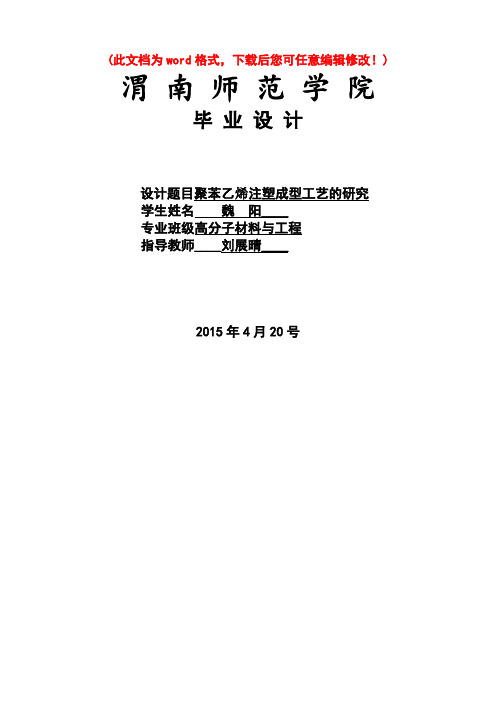
(此文档为word格式,下载后您可任意编辑修改!) 渭南师范学院毕业设计设计题目聚苯乙烯注塑成型工艺的研究学生姓名魏阳____专业班级高分子材料与工程指导教师____刘展晴____2015年4月20号本论文详细介绍了聚苯乙烯(PS)塑料的注射成型技术,结合产品的模具设计,对成型工艺进行了分析讨论;通过对典型PS塑料制品的加工工艺过程的研究,对PS塑料制品生产中的缺陷、原因及解决方法进行了论述。
结果表明,PS作为通用塑料,因其具有良好的性能,在结构复杂的工艺品生产中应用效果好,而且,合理的设计可以使模具结构大大简化。
[关键词]PS 塑料;注射成型;技术;探讨1. PS 塑料成型特性分析1. 聚苯乙烯简介()聚苯乙烯(PS)是指有苯乙烯单体经自由基缩聚反应合成的聚合物,英文名称为Polystyrene,简称PS。
玻璃化温度80~90℃,非晶态密度1.04~1.06克立方厘米,晶体密度1.11~1.12克立方厘米,熔融温度240℃,电阻率为1020~1022欧·厘米[1]。
导热系数30℃时0.116瓦(米·开)。
通常的聚苯乙烯为非晶态无规聚合物,具有优良的绝热、绝缘和透明性,长期使用温度0~70℃,低温易开裂。
此外还有全同和间同立构聚苯乙烯。
普通聚苯乙烯树脂属无定形高分子聚合物,聚苯乙烯大分子链的侧基为苯环,大体积侧基为苯环的无规排列决定了聚苯乙烯的物理化学性质,如透明度高、刚度大、玻璃化温度高,性脆等。
可发性聚苯乙烯为在普通聚苯乙烯中浸渍低沸点的物理发泡剂制成,加工过程中受热发泡,专用于制作泡沫塑料产品。
高抗冲聚苯乙烯为苯乙烯和丁二烯的共聚物间规聚苯乙烯为间同结构,采用茂金属催化剂生产,是近年来发展的聚苯乙烯新品种,性能好,属于工程塑料自从20世纪30年代初期聚苯乙烯第一次在德国实现了工业生产以后,它的应用领域也在不断扩大,迄今为止,聚苯乙烯以实现了规模化、跨越式发展。
聚苯乙烯具有优越的抗水防潮性、轻质、高硬度、高抗冲性、保温性能好等特性,聚苯乙烯 (PS)是一种无色透明的热塑性树脂,PS的分子量过高,加工困难,所以通常聚苯乙烯的分子量为5~20万。
塑料注射成型模具的设计 模具论文

绪论国际塑料模具工业的发展的新动态快速模具( Rapid Tooling以下简称RT)制造技术是一种快捷、方便、实用的模具制造技术,是传统金属模具所不能涵盖的,亦无法取代的制模手段,它既是模具制造的一个重要分支,又是对传统金属模具的有力补充。
随着社会需要和科学技术的发展,产品的竞争愈来愈激烈,更新的周期越来越短,因而要求设计者不但能根据市场的要求很快地设计出新产品,而且能在尽可能短的时间内制造出产品,进行必要的性能测试,征求用户的意见并进行修改,最后形成能投放市场的定型产品。
用传统方法制作样件时,需采用多种机械加工机床,以及相应的工卡量具,既费时、成本又高,根本不适应日新月异的变化。
正是基于这样一个背景,快速原型、快速模具、快速样件的快速制作工艺相继涌现。
快速原型制造技术(Rapid Prototyping以下简称RP)是80年代末发展起来的一项高新技术,它是集CAD/CAM技术、激光技术、计算机数据控制技术(CNC)、精密伺服驱动技术和高分子材料合成技术于一体。
RP技术的原理就是:将计算机内的三维实体模型进行分层切片得到各层截面的轮廓,计算机据此信息控制激光器有选择地固化一层层的液态光敏树脂,形成一系列具有微小厚度的片状实体,再逐层聚合堆积,形成一个与所设计同样的三维实体模型,这就是第一个实物原型。
当然,原型基材不同,成型工艺亦不尽相同,但其原理是一致的。
自3D SYSTEM公司1988年推出的第一台SLA成型机后,Vantico公司适时推出的一系列光固化树脂,在全球所有的3D公司生产的SLA成型机上大量使用,表现出精度高、韧性好、耐候性强、适用范围广的特点,目前已在众多的SLA成型机上得以广泛的使用。
有了原型,接下来的后续工序即是快速模具和快速制件,Vantico公司拥有三种获取快速制模和快速制件的制作工艺,即真空注型工艺,低压灌注工艺和高温树脂型腔模具工艺。
真空注型工艺。
即用原型来翻制硅胶软模或聚氨酯软模,将硅胶或聚氨酯树脂浇入置有原型的容器内,待软模完全固化后,沿分型面裁切软模,取出原型,再将软模合模后置于带有真空装置的真空注型机内,浇注改性的聚氨酯树脂,十几分钟后,待树脂固化完毕(必要时须进行后固化处理),就可以脱模并获得形状与原型一致的塑料制件。
毕业设计论文塑料注射成型
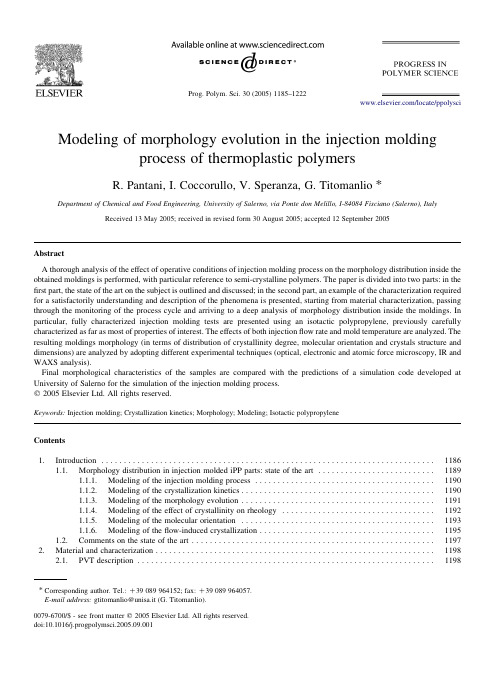
Modeling of morphology evolution in the injection moldingprocess of thermoplastic polymersR.Pantani,I.Coccorullo,V.Speranza,G.Titomanlio* Department of Chemical and Food Engineering,University of Salerno,via Ponte don Melillo,I-84084Fisciano(Salerno),Italy Received13May2005;received in revised form30August2005;accepted12September2005AbstractA thorough analysis of the effect of operative conditions of injection molding process on the morphology distribution inside the obtained moldings is performed,with particular reference to semi-crystalline polymers.The paper is divided into two parts:in the first part,the state of the art on the subject is outlined and discussed;in the second part,an example of the characterization required for a satisfactorily understanding and description of the phenomena is presented,starting from material characterization,passing through the monitoring of the process cycle and arriving to a deep analysis of morphology distribution inside the moldings.In particular,fully characterized injection molding tests are presented using an isotactic polypropylene,previously carefully characterized as far as most of properties of interest.The effects of both injectionflow rate and mold temperature are analyzed.The resulting moldings morphology(in terms of distribution of crystallinity degree,molecular orientation and crystals structure and dimensions)are analyzed by adopting different experimental techniques(optical,electronic and atomic force microscopy,IR and WAXS analysis).Final morphological characteristics of the samples are compared with the predictions of a simulation code developed at University of Salerno for the simulation of the injection molding process.q2005Elsevier Ltd.All rights reserved.Keywords:Injection molding;Crystallization kinetics;Morphology;Modeling;Isotactic polypropyleneContents1.Introduction (1186)1.1.Morphology distribution in injection molded iPP parts:state of the art (1189)1.1.1.Modeling of the injection molding process (1190)1.1.2.Modeling of the crystallization kinetics (1190)1.1.3.Modeling of the morphology evolution (1191)1.1.4.Modeling of the effect of crystallinity on rheology (1192)1.1.5.Modeling of the molecular orientation (1193)1.1.6.Modeling of theflow-induced crystallization (1195)ments on the state of the art (1197)2.Material and characterization (1198)2.1.PVT description (1198)*Corresponding author.Tel.:C39089964152;fax:C39089964057.E-mail address:gtitomanlio@unisa.it(G.Titomanlio).2.2.Quiescent crystallization kinetics (1198)2.3.Viscosity (1199)2.4.Viscoelastic behavior (1200)3.Injection molding tests and analysis of the moldings (1200)3.1.Injection molding tests and sample preparation (1200)3.2.Microscopy (1202)3.2.1.Optical microscopy (1202)3.2.2.SEM and AFM analysis (1202)3.3.Distribution of crystallinity (1202)3.3.1.IR analysis (1202)3.3.2.X-ray analysis (1203)3.4.Distribution of molecular orientation (1203)4.Analysis of experimental results (1203)4.1.Injection molding tests (1203)4.2.Morphology distribution along thickness direction (1204)4.2.1.Optical microscopy (1204)4.2.2.SEM and AFM analysis (1204)4.3.Morphology distribution alongflow direction (1208)4.4.Distribution of crystallinity (1210)4.4.1.Distribution of crystallinity along thickness direction (1210)4.4.2.Crystallinity distribution alongflow direction (1212)4.5.Distribution of molecular orientation (1212)4.5.1.Orientation along thickness direction (1212)4.5.2.Orientation alongflow direction (1213)4.5.3.Direction of orientation (1214)5.Simulation (1214)5.1.Pressure curves (1215)5.2.Morphology distribution (1215)5.3.Molecular orientation (1216)5.3.1.Molecular orientation distribution along thickness direction (1216)5.3.2.Molecular orientation distribution alongflow direction (1216)5.3.3.Direction of orientation (1217)5.4.Crystallinity distribution (1217)6.Conclusions (1217)References (1219)1.IntroductionInjection molding is one of the most widely employed methods for manufacturing polymeric products.Three main steps are recognized in the molding:filling,packing/holding and cooling.During thefilling stage,a hot polymer melt rapidlyfills a cold mold reproducing a cavity of the desired product shape. During the packing/holding stage,the pressure is raised and extra material is forced into the mold to compensate for the effects that both temperature decrease and crystallinity development determine on density during solidification.The cooling stage starts at the solidification of a thin section at cavity entrance (gate),starting from that instant no more material can enter or exit from the mold impression and holding pressure can be released.When the solid layer on the mold surface reaches a thickness sufficient to assure required rigidity,the product is ejected from the mold.Due to the thermomechanical history experienced by the polymer during processing,macromolecules in injection-molded objects present a local order.This order is referred to as‘morphology’which literally means‘the study of the form’where form stands for the shape and arrangement of parts of the object.When referred to polymers,the word morphology is adopted to indicate:–crystallinity,which is the relative volume occupied by each of the crystalline phases,including mesophases;–dimensions,shape,distribution and orientation of the crystallites;–orientation of amorphous phase.R.Pantani et al./Prog.Polym.Sci.30(2005)1185–1222 1186R.Pantani et al./Prog.Polym.Sci.30(2005)1185–12221187Apart from the scientific interest in understandingthe mechanisms leading to different order levels inside a polymer,the great technological importance of morphology relies on the fact that polymer character-istics (above all mechanical,but also optical,electrical,transport and chemical)are to a great extent affected by morphology.For instance,crystallinity has a pro-nounced effect on the mechanical properties of the bulk material since crystals are generally stiffer than amorphous material,and also orientation induces anisotropy and other changes in mechanical properties.In this work,a thorough analysis of the effect of injection molding operative conditions on morphology distribution in moldings with particular reference to crystalline materials is performed.The aim of the paper is twofold:first,to outline the state of the art on the subject;second,to present an example of the characterization required for asatisfactorilyR.Pantani et al./Prog.Polym.Sci.30(2005)1185–12221188understanding and description of the phenomena, starting from material description,passing through the monitoring of the process cycle and arriving to a deep analysis of morphology distribution inside the mold-ings.To these purposes,fully characterized injection molding tests were performed using an isotactic polypropylene,previously carefully characterized as far as most of properties of interest,in particular quiescent nucleation density,spherulitic growth rate and rheological properties(viscosity and relaxation time)were determined.The resulting moldings mor-phology(in terms of distribution of crystallinity degree, molecular orientation and crystals structure and dimensions)was analyzed by adopting different experimental techniques(optical,electronic and atomic force microscopy,IR and WAXS analysis).Final morphological characteristics of the samples were compared with the predictions of a simulation code developed at University of Salerno for the simulation of the injection molding process.The effects of both injectionflow rate and mold temperature were analyzed.1.1.Morphology distribution in injection molded iPP parts:state of the artFrom many experimental observations,it is shown that a highly oriented lamellar crystallite microstructure, usually referred to as‘skin layer’forms close to the surface of injection molded articles of semi-crystalline polymers.Far from the wall,the melt is allowed to crystallize three dimensionally to form spherulitic structures.Relative dimensions and morphology of both skin and core layers are dependent on local thermo-mechanical history,which is characterized on the surface by high stress levels,decreasing to very small values toward the core region.As a result,the skin and the core reveal distinct characteristics across the thickness and also along theflow path[1].Structural and morphological characterization of the injection molded polypropylene has attracted the interest of researchers in the past three decades.In the early seventies,Kantz et al.[2]studied the morphology of injection molded iPP tensile bars by using optical microscopy and X-ray diffraction.The microscopic results revealed the presence of three distinct crystalline zones on the cross-section:a highly oriented non-spherulitic skin;a shear zone with molecular chains oriented essentially parallel to the injection direction;a spherulitic core with essentially no preferred orientation.The X-ray diffraction studies indicated that the skin layer contains biaxially oriented crystallites due to the biaxial extensionalflow at theflow front.A similar multilayered morphology was also reported by Menges et al.[3].Later on,Fujiyama et al.[4] investigated the skin–core morphology of injection molded iPP samples using X-ray Small and Wide Angle Scattering techniques,and suggested that the shear region contains shish–kebab structures.The same shish–kebab structure was observed by Wenig and Herzog in the shear region of their molded samples[5].A similar investigation was conducted by Titomanlio and co-workers[6],who analyzed the morphology distribution in injection moldings of iPP. They observed a skin–core morphology distribution with an isotropic spherulitic core,a skin layer characterized by afine crystalline structure and an intermediate layer appearing as a dark band in crossed polarized light,this layer being characterized by high crystallinity.Kalay and Bevis[7]pointed out that,although iPP crystallizes essentially in the a-form,a small amount of b-form can be found in the skin layer and in the shear region.The amount of b-form was found to increase by effect of high shear rates[8].A wide analysis on the effect of processing conditions on the morphology of injection molded iPP was conducted by Viana et al.[9]and,more recently, by Mendoza et al.[10].In particular,Mendoza et al. report that the highest level of crystallinity orientation is found inside the shear zone and that a high level of orientation was also found in the skin layer,with an orientation angle tilted toward the core.It is rather difficult to theoretically establish the relationship between the observed microstructure and processing conditions.Indeed,a model of the injection molding process able to predict morphology distribution in thefinal samples is not yet available,even if it would be of enormous strategic importance.This is mainly because a complete understanding of crystallization kinetics in processing conditions(high cooling rates and pressures,strong and complexflowfields)has not yet been reached.In this section,the most relevant aspects for process modeling and morphology development are identified. In particular,a successful path leading to a reliable description of morphology evolution during polymer processing should necessarily pass through:–a good description of morphology evolution under quiescent conditions(accounting all competing crystallization processes),including the range of cooling rates characteristic of processing operations (from1to10008C/s);R.Pantani et al./Prog.Polym.Sci.30(2005)1185–12221189–a description capturing the main features of melt morphology(orientation and stretch)evolution under processing conditions;–a good coupling of the two(quiescent crystallization and orientation)in order to capture the effect of crystallinity on viscosity and the effect offlow on crystallization kinetics.The points listed above outline the strategy to be followed in order to achieve the basic understanding for a satisfactory description of morphology evolution during all polymer processing operations.In the following,the state of art for each of those points will be analyzed in a dedicated section.1.1.1.Modeling of the injection molding processThefirst step in the prediction of the morphology distribution within injection moldings is obviously the thermo-mechanical simulation of the process.Much of the efforts in the past were focused on the prediction of pressure and temperature evolution during the process and on the prediction of the melt front advancement [11–15].The simulation of injection molding involves the simultaneous solution of the mass,energy and momentum balance equations.Thefluid is non-New-tonian(and viscoelastic)with all parameters dependent upon temperature,pressure,crystallinity,which are all function of pressibility cannot be neglected as theflow during the packing/holding step is determined by density changes due to temperature, pressure and crystallinity evolution.Indeed,apart from some attempts to introduce a full 3D approach[16–19],the analysis is currently still often restricted to the Hele–Shaw(or thinfilm) approximation,which is warranted by the fact that most injection molded parts have the characteristic of being thin.Furthermore,it is recognized that the viscoelastic behavior of the polymer only marginally influences theflow kinematics[20–22]thus the melt is normally considered as a non-Newtonian viscousfluid for the description of pressure and velocity gradients evolution.Some examples of adopting a viscoelastic constitutive equation in the momentum balance equations are found in the literature[23],but the improvements in accuracy do not justify a considerable extension of computational effort.It has to be mentioned that the analysis of some features of kinematics and temperature gradients affecting the description of morphology need a more accurate description with respect to the analysis of pressure distributions.Some aspects of the process which were often neglected and may have a critical importance are the description of the heat transfer at polymer–mold interface[24–26]and of the effect of mold deformation[24,27,28].Another aspect of particular interest to the develop-ment of morphology is the fountainflow[29–32], which is often neglected being restricted to a rather small region at theflow front and close to the mold walls.1.1.2.Modeling of the crystallization kineticsIt is obvious that the description of crystallization kinetics is necessary if thefinal morphology of the molded object wants to be described.Also,the development of a crystalline degree during the process influences the evolution of all material properties like density and,above all,viscosity(see below).Further-more,crystallization kinetics enters explicitly in the generation term of the energy balance,through the latent heat of crystallization[26,33].It is therefore clear that the crystallinity degree is not only a result of simulation but also(and above all)a phenomenon to be kept into account in each step of process modeling.In spite of its dramatic influence on the process,the efforts to simulate the injection molding of semi-crystalline polymers are crude in most of the commercial software for processing simulation and rather scarce in the fleur and Kamal[34],Papatanasiu[35], Titomanlio et al.[15],Han and Wang[36],Ito et al.[37],Manzione[38],Guo and Isayev[26],and Hieber [25]adopted the following equation(Kolmogoroff–Avrami–Evans,KAE)to predict the development of crystallinityd xd tZð1K xÞd d cd t(1)where x is the relative degree of crystallization;d c is the undisturbed volume fraction of the crystals(if no impingement would occur).A significant improvement in the prediction of crystallinity development was introduced by Titoman-lio and co-workers[39]who kept into account the possibility of the formation of different crystalline phases.This was done by assuming a parallel of several non-interacting kinetic processes competing for the available amorphous volume.The evolution of each phase can thus be described byd x id tZð1K xÞd d c id t(2)where the subscript i stands for a particular phase,x i is the relative degree of crystallization,x ZPix i and d c iR.Pantani et al./Prog.Polym.Sci.30(2005)1185–1222 1190is the expectancy of volume fraction of each phase if no impingement would occur.Eq.(2)assumes that,for each phase,the probability of the fraction increase of a single crystalline phase is simply the product of the rate of growth of the corresponding undisturbed volume fraction and of the amount of available amorphous fraction.By summing up the phase evolution equations of all phases(Eq.(2))over the index i,and solving the resulting differential equation,one simply obtainsxðtÞZ1K exp½K d cðtÞ (3)where d c Z Pid c i and Eq.(1)is recovered.It was shown by Coccorullo et al.[40]with reference to an iPP,that the description of the kinetic competition between phases is crucial to a reliable prediction of solidified structures:indeed,it is not possible to describe iPP crystallization kinetics in the range of cooling rates of interest for processing(i.e.up to several hundreds of8C/s)if the mesomorphic phase is neglected:in the cooling rate range10–1008C/s, spherulite crystals in the a-phase are overcome by the formation of the mesophase.Furthermore,it has been found that in some conditions(mainly at pressures higher than100MPa,and low cooling rates),the g-phase can also form[41].In spite of this,the presence of different crystalline phases is usually neglected in the literature,essentially because the range of cooling rates investigated for characterization falls in the DSC range (well lower than typical cooling rates of interest for the process)and only one crystalline phase is formed for iPP at low cooling rates.It has to be noticed that for iPP,which presents a T g well lower than ambient temperature,high values of crystallinity degree are always found in solids which passed through ambient temperature,and the cooling rate can only determine which crystalline phase forms, roughly a-phase at low cooling rates(below about 508C/s)and mesomorphic phase at higher cooling rates.The most widespread approach to the description of kinetic constant is the isokinetic approach introduced by Nakamura et al.According to this model,d c in Eq.(1)is calculated asd cðtÞZ ln2ðt0KðTðsÞÞd s2 435n(4)where K is the kinetic constant and n is the so-called Avrami index.When introduced as in Eq.(4),the reciprocal of the kinetic constant is a characteristic time for crystallization,namely the crystallization half-time, t05.If a polymer is cooled through the crystallization temperature,crystallization takes place at the tempera-ture at which crystallization half-time is of the order of characteristic cooling time t q defined ast q Z D T=q(5) where q is the cooling rate and D T is a temperature interval over which the crystallization kinetic constant changes of at least one order of magnitude.The temperature dependence of the kinetic constant is modeled using some analytical function which,in the simplest approach,is described by a Gaussian shaped curve:KðTÞZ K0exp K4ln2ðT K T maxÞ2D2(6)The following Hoffman–Lauritzen expression[42] is also commonly adopted:K½TðtÞ Z K0exp KUÃR$ðTðtÞK T NÞ!exp KKÃ$ðTðtÞC T mÞ2TðtÞ2$ðT m K TðtÞÞð7ÞBoth equations describe a bell shaped curve with a maximum which for Eq.(6)is located at T Z T max and for Eq.(7)lies at a temperature between T m(the melting temperature)and T N(which is classically assumed to be 308C below the glass transition temperature).Accord-ing to Eq.(7),the kinetic constant is exactly zero at T Z T m and at T Z T N,whereas Eq.(6)describes a reduction of several orders of magnitude when the temperature departs from T max of a value higher than2D.It is worth mentioning that only three parameters are needed for Eq.(6),whereas Eq.(7)needs the definition offive parameters.Some authors[43,44]couple the above equations with the so-called‘induction time’,which can be defined as the time the crystallization process starts, when the temperature is below the equilibrium melting temperature.It is normally described as[45]Dt indDtZðT0m K TÞat m(8)where t m,T0m and a are material constants.It should be mentioned that it has been found[46,47]that there is no need to explicitly incorporate an induction time when the modeling is based upon the KAE equation(Eq.(1)).1.1.3.Modeling of the morphology evolutionDespite of the fact that the approaches based on Eq.(4)do represent a significant step toward the descriptionR.Pantani et al./Prog.Polym.Sci.30(2005)1185–12221191of morphology,it has often been pointed out in the literature that the isokinetic approach on which Nakamura’s equation (Eq.(4))is based does not describe details of structure formation [48].For instance,the well-known experience that,with many polymers,the number of spherulites in the final solid sample increases strongly with increasing cooling rate,is indeed not taken into account by this approach.Furthermore,Eq.(4)describes an increase of crystal-linity (at constant temperature)depending only on the current value of crystallinity degree itself,whereas it is expected that the crystallization rate should depend also on the number of crystalline entities present in the material.These limits are overcome by considering the crystallization phenomenon as the consequence of nucleation and growth.Kolmogoroff’s model [49],which describes crystallinity evolution accounting of the number of nuclei per unit volume and spherulitic growth rate can then be applied.In this case,d c in Eq.(1)is described asd ðt ÞZ C m ðt 0d N ðs Þd s$ðt sG ðu Þd u 2435nd s (9)where C m is a shape factor (C 3Z 4/3p ,for spherical growth),G (T (t ))is the linear growth rate,and N (T (t ))is the nucleation density.The following Hoffman–Lauritzen expression is normally adopted for the growth rateG ½T ðt Þ Z G 0exp KUR $ðT ðt ÞK T N Þ!exp K K g $ðT ðt ÞC T m Þ2T ðt Þ2$ðT m K T ðt ÞÞð10ÞEqs.(7)and (10)have the same form,however the values of the constants are different.The nucleation mechanism can be either homo-geneous or heterogeneous.In the case of heterogeneous nucleation,two equations are reported in the literature,both describing the nucleation density as a function of temperature [37,50]:N ðT ðt ÞÞZ N 0exp ½j $ðT m K T ðt ÞÞ (11)N ðT ðt ÞÞZ N 0exp K 3$T mT ðt ÞðT m K T ðt ÞÞ(12)In the case of homogeneous nucleation,the nucleation rate rather than the nucleation density is function of temperature,and a Hoffman–Lauritzen expression isadoptedd N ðT ðt ÞÞd t Z N 0exp K C 1ðT ðt ÞK T N Þ!exp KC 2$ðT ðt ÞC T m ÞT ðt Þ$ðT m K T ðt ÞÞð13ÞConcentration of nucleating particles is usually quite significant in commercial polymers,and thus hetero-geneous nucleation becomes the dominant mechanism.When Kolmogoroff’s approach is followed,the number N a of active nuclei at the end of the crystal-lization process can be calculated as [48]N a ;final Zðt final 0d N ½T ðs Þd sð1K x ðs ÞÞd s (14)and the average dimension of crystalline structures can be attained by geometrical considerations.Pantani et al.[51]and Zuidema et al.[22]exploited this method to describe the distribution of crystallinity and the final average radius of the spherulites in injection moldings of polypropylene;in particular,they adopted the following equationR Z ffiffiffiffiffiffiffiffiffiffiffiffiffiffiffiffiffiffiffi3x a ;final 4p N a ;final 3s (15)A different approach is also present in the literature,somehow halfway between Nakamura’s and Kolmo-goroff’s models:the growth rate (G )and the kinetic constant (K )are described independently,and the number of active nuclei (and consequently the average dimensions of crystalline entities)can be obtained by coupling Eqs.(4)and (9)asN a ðT ÞZ 3ln 24p K ðT ÞG ðT Þ 3(16)where heterogeneous nucleation and spherical growth is assumed (Avrami’s index Z 3).Guo et al.[43]adopted this approach to describe the dimensions of spherulites in injection moldings of polypropylene.1.1.4.Modeling of the effect of crystallinity on rheology As mentioned above,crystallization has a dramatic influence on material viscosity.This phenomenon must obviously be taken into account and,indeed,the solidification of a semi-crystalline material is essen-tially caused by crystallization rather than by tempera-ture in normal processing conditions.Despite of the importance of the subject,the relevant literature on the effect of crystallinity on viscosity isR.Pantani et al./Prog.Polym.Sci.30(2005)1185–12221192rather scarce.This might be due to the difficulties in measuring simultaneously rheological properties and crystallinity evolution during the same tests.Apart from some attempts to obtain simultaneous measure-ments of crystallinity and viscosity by special setups [52,53],more often viscosity and crystallinity are measured during separate tests having the same thermal history,thus greatly simplifying the experimental approach.Nevertheless,very few works can be retrieved in the literature in which(shear or complex) viscosity can be somehow linked to a crystallinity development.This is the case of Winter and co-workers [54],Vleeshouwers and Meijer[55](crystallinity evolution can be drawn from Swartjes[56]),Boutahar et al.[57],Titomanlio et al.[15],Han and Wang[36], Floudas et al.[58],Wassner and Maier[59],Pantani et al.[60],Pogodina et al.[61],Acierno and Grizzuti[62].All the authors essentially agree that melt viscosity experiences an abrupt increase when crystallinity degree reaches a certain‘critical’value,x c[15]. However,little agreement is found in the literature on the value of this critical crystallinity degree:assuming that x c is reached when the viscosity increases of one order of magnitude with respect to the molten state,it is found in the literature that,for iPP,x c ranges from a value of a few percent[15,62,60,58]up to values of20–30%[58,61]or even higher than40%[59,54,57].Some studies are also reported on the secondary effects of relevant variables such as temperature or shear rate(or frequency)on the dependence of crystallinity on viscosity.As for the effect of temperature,Titomanlio[15]found for an iPP that the increase of viscosity for the same crystallinity degree was higher at lower temperatures,whereas Winter[63] reports the opposite trend for a thermoplastic elasto-meric polypropylene.As for the effect of shear rate,a general agreement is found in the literature that the increase of viscosity for the same crystallinity degree is lower at higher deformation rates[62,61,57].Essentially,the equations adopted to describe the effect of crystallinity on viscosity of polymers can be grouped into two main categories:–equations based on suspensions theories(for a review,see[64]or[65]);–empirical equations.Some of the equations adopted in the literature with regard to polymer processing are summarized in Table1.Apart from Eq.(17)adopted by Katayama and Yoon [66],all equations predict a sharp increase of viscosity on increasing crystallinity,sometimes reaching infinite (Eqs.(18)and(21)).All authors consider that the relevant variable is the volume occupied by crystalline entities(i.e.x),even if the dimensions of the crystals should reasonably have an effect.1.1.5.Modeling of the molecular orientationOne of the most challenging problems to present day polymer science regards the reliable prediction of molecular orientation during transformation processes. Indeed,although pressure and velocity distribution during injection molding can be satisfactorily described by viscous models,details of the viscoelastic nature of the polymer need to be accounted for in the descriptionTable1List of the most used equations to describe the effect of crystallinity on viscosityEquation Author Derivation Parameters h=h0Z1C a0x(17)Katayama[66]Suspensions a Z99h=h0Z1=ðx K x cÞa0(18)Ziabicki[67]Empirical x c Z0.1h=h0Z1C a1expðK a2=x a3Þ(19)Titomanlio[15],also adopted byGuo[68]and Hieber[25]Empiricalh=h0Z expða1x a2Þ(20)Shimizu[69],also adopted byZuidema[22]and Hieber[25]Empiricalh=h0Z1Cðx=a1Þa2=ð1Kðx=a1Þa2Þ(21)Tanner[70]Empirical,basedon suspensionsa1Z0.44for compact crystallitesa1Z0.68for spherical crystallitesh=h0Z expða1x C a2x2Þ(22)Han[36]Empiricalh=h0Z1C a1x C a2x2(23)Tanner[71]Empirical a1Z0.54,a2Z4,x!0.4h=h0Zð1K x=a0ÞK2(24)Metzner[65],also adopted byTanner[70]Suspensions a Z0.68for smooth spheresR.Pantani et al./Prog.Polym.Sci.30(2005)1185–12221193。
注塑模具毕业论文(注塑模具)
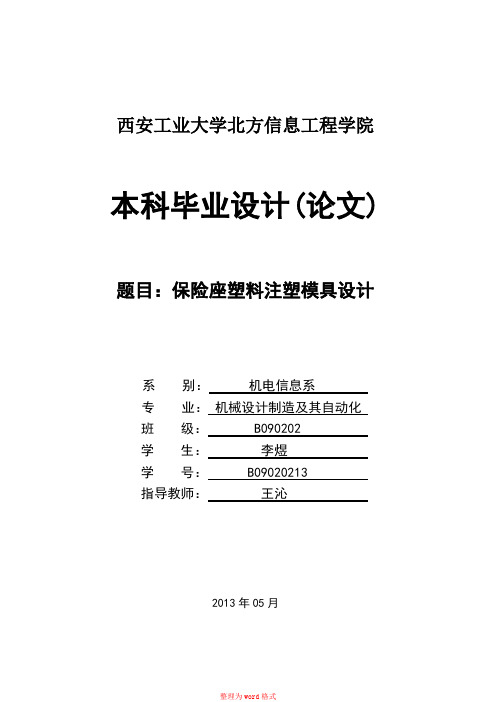
西安工业大学北方信息工程学院本科毕业设计(论文)题目:保险座塑料注塑模具设计系别:机电信息系专业:机械设计制造及其自动化班级: B090202学生:李煜学号: B09020213指导教师:王沁2013年05月毕业设计(论文)任务书系别 机电信息系 专业 机械设计制造及其自动化 班级B090202姓名李煜学号B090202131.毕业设计(论文)题目: 保险座塑料注射模具设计2.题目背景和意义:塑料注射模具的设计是在当今大部分塑料制品生产中的第一个环节,各行各业,各种产品几乎都要用到注射模生产的塑料零配件,因此掌握塑料注射模的设计技能是机械设计工程师的基本要求之一。
通过塑料制品的注塑模具设计,能够熟悉和掌握塑料制品设计全过程,能够根据不同塑料材料的性能,塑料结构特点,选择适当的模具结构,并掌握模具主要零件的强度计算及主要零件的尺寸确定,掌握材料的选择,通过该设计,应能检查外语翻译及理解能力,能熟练运用计算机进行设计和绘图。
通过设计后,能够完全独立完成中等难度以上塑料注射模具设计,并能在选材,结构设计等方面进行经济技术分析。
3.设计(论文)的主要内容(理工科含技术指标):(1)分析塑料的材料、形状、结构对注塑成型的影响;(2)进行模具的结构设计:包括注塑机的选型,分型面得确定,浇口形式的选择等;(3)完成有关成型零件工作尺寸的计算。
成型型腔壁厚计算;冷却系统设计等;(4)完成模具装配图及主要零件图的绘制;(5)论文撰写符合管理规范手册要求。
4.设计的基本要求及进度安排(含起始时间、设计地点):第1-3周,选题、收集资料了解模具设计的背景、理解题目、开题报告第4-6周,分析塑件的形状特点,确定方案,完成英文文献的翻译第7-15周,进行模具的结构设计,绘制模具装配图及零件图,完成相关的计算第16周,按照论文格式要求书写论文,提交论文,准备答辩。
5.毕业设计(论文)的工作量要求 撰写15000字论文① 实验(时数)*或实习(天数):② 图纸(幅面和张数)*: 折合A0图纸3张③ 其他要求: 查阅资料不少于15篇指导教师签名: 年 月 日学生签名: 年 月 日系主任审批: 年 月 日说明:1本表一式二份,一份由学生装订入册,一份教师自留。
注塑模毕业论文【范本模板】
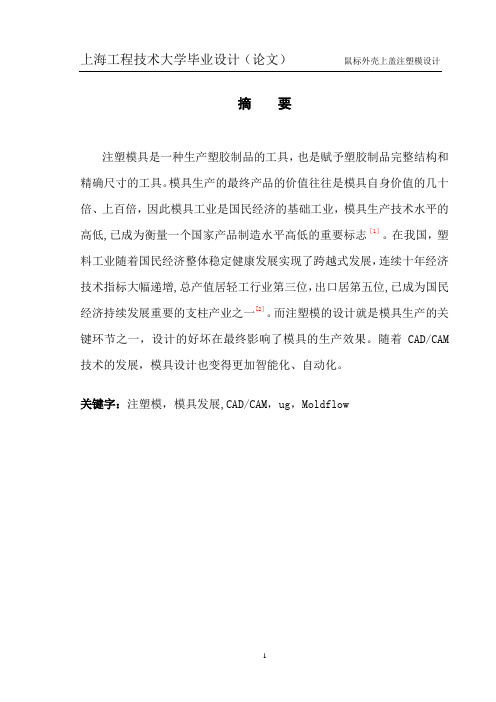
摘要注塑模具是一种生产塑胶制品的工具,也是赋予塑胶制品完整结构和精确尺寸的工具。
模具生产的最终产品的价值往往是模具自身价值的几十倍、上百倍,因此模具工业是国民经济的基础工业,模具生产技术水平的高低,已成为衡量一个国家产品制造水平高低的重要标志[1]。
在我国,塑料工业随着国民经济整体稳定健康发展实现了跨越式发展,连续十年经济技术指标大幅递增,总产值居轻工行业第三位,出口居第五位,已成为国民经济持续发展重要的支柱产业之一[2]。
而注塑模的设计就是模具生产的关键环节之一,设计的好坏在最终影响了模具的生产效果。
随着CAD/CAM 技术的发展,模具设计也变得更加智能化、自动化。
关键字:注塑模,模具发展,CAD/CAM,ug,MoldflowInjection Mold Design of Mouse shell upper coverABSTRACTInjection mold is a tool for the production of plastic products, plastic products also give the exact dimensions of the complete structure and tools. Mold production value of the final product is often several times the value of the mold itself, a hundred times, so the mold industry is the basic industry, mold production technology level of the national economy,has become a measure of the level of a country's manufacturing important symbol。
塑料盖注塑工艺分析与模具设计毕业论文完整版本

第1章概论1.1 课题背景及意义市场竞争的日趋激烈,使得产品的功能日趋多元化,产品的生命周期不断缩短,塑料产品结构日趋多样化和复杂化,客户对产品质量的要求也越来越高。
这在一定程度上决定了模具设计和注射成型过程的复杂性,有些注射成型问题连有经验的模具设计师和注射工艺师都很难把握。
而传统的注射模设计首先考虑的是模具结构本身的需要,之后考虑的才是注射制品的需要。
例如,常规的注射模设计通常是根据经验确定浇注系统和冷却系统,而不是根据流动分析来确定,最后在试模过程中通过反复的调整模具的浇注系统和冷却系统参数来勉强达到产品的质量要求。
模具试模周期过长、试模成本过高严重影响了企业的竞争力。
因此,对塑料熔体的注射成型过程的计算机模拟对优化产品结构设计、模具设计以及注射成型工艺具有非常重要的指导意义[1][2][3]。
1.2 本课题及相关领域的国内外现状及发展1.2.1 塑料模功能分子材料加工领域中,用于塑料制品成形的模具,称为塑料成形模具,简称塑料模。
塑料模优化设计,是当前高分子材料加工领域中的重大课题。
在塑料材料、制品设计及加工工艺确定以后,塑料模设计对制品质量与产量,就具有决定性的影响。
首先,模腔形状、流道尺寸、表面粗糙度、分型面、浇注与排气位置选择、脱模方式以及定型方法的确定等,均对制品尺寸精度和形状精度以及塑件的物理力学性能、内应力大小、表观质量与内在质量等,起着十分重要的影响。
其次,在塑件加工过程中,塑料模结构的合理性,对操作的难易程度,具有重要的影响。
再次,塑料模对塑件成本也有相当大的影响,除简易模具外,一般说来制模费用是十分昂贵的,大型塑料模更是如此。
现代塑料制品生产中,合理的加工工艺、高效率的设备和先进的模具,被誉为塑料制品成形技术的“三大支柱”。
尤其是塑料模对实现塑件加工工艺要求、塑件使用要求和塑件外观造型要求起着无可代替的作用。
高效全自动化设备,也只有装上能自动化生产的模具,才能发挥其应有的效能。
注塑毕业论文1

注塑毕业论文1注塑工艺在塑料制品生产中的应用与优化摘要:注塑成型作为一种重要的塑料加工方法,广泛应用于各个领域。
本文通过对注塑工艺原理、流程的详细阐述,结合实际生产中的问题和案例,深入探讨了注塑工艺参数对制品质量的影响,并提出了相应的优化措施,以提高塑料制品的性能和生产效率。
关键词:注塑工艺;塑料制品;参数优化一、引言塑料制品在现代社会中扮演着举足轻重的角色,从日常生活用品到工业零部件,其应用范围不断扩大。
注塑成型作为塑料制品生产的主要方法之一,具有生产效率高、制品精度高、可成型复杂形状等优点。
因此,深入研究注塑工艺对于提高塑料制品质量和生产效益具有重要意义。
二、注塑工艺原理注塑成型是将塑料颗粒加热熔融后,通过注塑机的螺杆将熔融塑料注入模具型腔,经过冷却固化后得到塑料制品的过程。
其基本原理是利用塑料的热塑性,在一定的温度和压力条件下,使塑料由固态转变为液态,并充满模具型腔,然后在冷却条件下固化成型。
三、注塑工艺流程注塑工艺流程主要包括塑料颗粒的干燥、塑化、注塑、保压、冷却、脱模等环节。
1、干燥塑料颗粒在储存和运输过程中可能会吸收水分,为了避免水分在注塑过程中引起气泡、银丝等缺陷,需要对塑料颗粒进行干燥处理。
干燥温度和时间根据塑料的种类和含水量而定。
2、塑化将干燥后的塑料颗粒加入注塑机的料筒中,通过加热和螺杆的旋转剪切作用,使塑料颗粒逐渐熔融并均匀混合,形成具有一定流动性的熔融塑料。
3、注塑注塑机的螺杆在液压系统的驱动下,将熔融塑料以一定的速度和压力注入模具型腔。
注塑速度和压力是影响注塑过程的重要参数,直接关系到制品的填充效果和质量。
4、保压在注塑完成后,螺杆继续向前推进,对模具型腔中的熔融塑料施加一定的压力,以补偿塑料冷却收缩产生的体积减小,防止制品出现缩孔、凹陷等缺陷。
5、冷却模具通过冷却系统进行冷却,使模具型腔中的熔融塑料迅速固化成型。
冷却时间的长短直接影响制品的生产效率和质量。
6、脱模当制品冷却固化完成后,通过模具的顶出机构将制品从模具中顶出,完成脱模过程。
注塑毕业设计

注塑毕业设计注塑是一种常用的塑料成型加工方法,广泛应用于各种塑料制品的生产中。
本次毕业设计以注塑加工为主题,设计了一个注塑模具,完成对一个小型塑料制品的生产。
首先,我根据所需塑料制品的尺寸和形状特点,设计了一个注塑模具的结构。
这个模具由模具基板、下模板和上模板三部分组成。
在下模板上制作了一个模板腔,用来容纳塑料料筒。
上模板上制作了一个模板芯,用来成型塑料制品的内部空间。
然后,我使用计算机辅助设计软件对注塑模具进行了三维建模,并进行了模具流动分析。
通过模具流动分析,我能够了解塑料在模具中的流动情况,根据结果对模具的结构进行了优化和调整,确保塑料在模具中的流动顺畅。
接下来,我使用数控机床对注塑模具进行加工。
首先,我根据模具图纸设置机床的工作参数,包括刀具的选择、移动速度和切削深度等。
然后,我使用数控编程软件编写代码,将模具图纸和工作参数转化为数控机床能够理解的指令。
最后,将代码输入数控机床,开始加工模具。
完成模具的加工后,我将模具安装到注塑机上,开始进行注塑加工。
首先,将塑料料筒装入注塑机的料斗中,并通过加热器将其加热至熔化状态。
然后,将熔化的塑料注入注塑机的射嘴中,并利用注塑机的压力和温度控制系统,将塑料注入模具腔中,并在模具芯的作用下形成塑料制品的内部空间。
最后,冷却模具,并打开模具,取出成品。
通过本次毕业设计,我对注塑加工有了更深入的了解。
通过设计注塑模具、进行模具流动分析、加工模具和进行注塑加工等环节的实践,我对注塑加工的工艺流程和技术要点有了更清晰的认识。
这次经历也让我对注塑加工这个行业有了更多的兴趣和热情,将来我希望能够在注塑加工领域有所发展。
毕业设计(论文)-注塑成型工艺和塑胶外观件的生产工艺流程[管理资料]
![毕业设计(论文)-注塑成型工艺和塑胶外观件的生产工艺流程[管理资料]](https://img.taocdn.com/s3/m/700216bac850ad02df804196.png)
1绪论塑料制品的应用塑料制品在日常生活中是最常常见到的,如在家用电器,仪器仪表,建筑器材,汽车工业,日用五金,通信器材以及医疗器械等众多领域,塑料制品的使用比例正迅猛增加。
这主要有以下原因:第一,塑料与金属材料相比有许多优点:容易加工,生产效率高;节约能源,绝缘性能好;质量轻,,比铝轻一半,比刚轻3/4,比强度高,具有突出的耐磨,耐腐蚀性等;第二,在日用和工业产品中,一个设计合理的塑料制品往往能代替多个传统金属结构件,加上利用工程塑料特有的性质,可以一次成型非常复杂的形状,并且还能设计成卡装结构,从而减少产品中装配的各种紧固件,降低了金属材料消耗量和加工及装配工时;第三,注塑成型是塑料加工中普遍采用的方法之一。
该方法适用于全部热塑性塑料和部分热固性塑料,制品成品数量比其他常规的金属成型方法要多得多。
由于注塑成型加工不仅产量多,而且适用于多种原料,能够成批,连续地生产,并且具有稳定的尺寸,容易实现生产的自动化和高速化,具有极高的经济效益。
因此,目前工业产品非金属化,金属制品塑料化的趋势日益明显。
注塑成型获得注塑制品的过程,称之为注塑成型或者注射成型,或者简单地称之为注塑。
注塑成型的基本过程是:颗粒状的高分子材料(以下简称为塑料)经过注塑机螺杆的挤压和加热,成为熔融状态的可以流动的熔体。
在螺杆的推动下,塑料熔体通过注塑机喷嘴,模具的主流道,分流道和浇口进入模具型腔,成型出具有一定形状和尺寸制品的过程。
注塑的结构是出产出符合用户要求的塑料制品。
要想取得合格的制品,必须要有设计合理,制造精良的模具,还需要有和该模具配套的先进的注塑设备(注塑机)以及合理的加工工艺。
因此,人们常将模具,注塑机以及工艺称之为注塑过程得以顺利进行的三个基本要素。
对于采用注塑成型加工方法生产塑料制品来说,合理的成型工艺即是三个基本要素中的加工工艺。
所谓成型工艺,简单说来就是将压力,温度,时间(速度)三大要素组成最合理的搭配。
在成型过程中,尤其是精密制品的成型,要想确立一组最佳的成型条件绝非易事,因为影响成型条件的因素很多,除制品的形状,模具结构,注塑设备,原材料等之外,电压的波动,环境温度的变化对成型都有一定的影响。
- 1、下载文档前请自行甄别文档内容的完整性,平台不提供额外的编辑、内容补充、找答案等附加服务。
- 2、"仅部分预览"的文档,不可在线预览部分如存在完整性等问题,可反馈申请退款(可完整预览的文档不适用该条件!)。
- 3、如文档侵犯您的权益,请联系客服反馈,我们会尽快为您处理(人工客服工作时间:9:00-18:30)。
渭南师范学院毕业设计设计题目聚苯乙烯注塑成型工艺的研究学生姓名魏阳____学号_______专业班级高分子材料与工程指导教师____刘展晴____2015年4月20号摘要本论文详细介绍了聚苯乙烯(PS)塑料的注射成型技术,结合产品的模具设计,对成型工艺进行了分析讨论;通过对典型PS塑料制品的加工工艺过程的研究,对PS塑料制品生产中的缺陷、原因及解决方法进行了论述。
结果表明,PS作为通用塑料,因其具有良好的性能,在结构复杂的工艺品生产中应用效果好,而且,合理的设计可以使模具结构大大简化。
[关键词]PS 塑料;注射成型;技术;探讨1. PS 塑料成型特性分析1. 聚苯乙烯简介()聚苯乙烯(PS)是指有苯乙烯单体经自由基缩聚反应合成的聚合物,英文名称为Polystyrene,简称PS。
玻璃化温度80~90℃,非晶态密度1.04~1.06克立方厘米,晶体密度1.11~1.12克立方厘米,熔融温度240℃,电阻率为1020~1022欧·厘米[1]。
导热系数30℃时0.116瓦(米·开)。
通常的聚苯乙烯为非晶态无规聚合物,具有优良的绝热、绝缘和透明性,长期使用温度0~70℃,低温易开裂。
此外还有全同和间同立构聚苯乙烯。
普通聚苯乙烯树脂属无定形高分子聚合物,聚苯乙烯大分子链的侧基为苯环,大体积侧基为苯环的无规排列决定了聚苯乙烯的物理化学性质,如透明度高、刚度大、玻璃化温度高,性脆等。
可发性聚苯乙烯为在普通聚苯乙烯中浸渍低沸点的物理发泡剂制成,加工过程中受热发泡,专用于制作泡沫塑料产品。
高抗冲聚苯乙烯为苯乙烯和丁二烯的共聚物间规聚苯乙烯为间同结构,采用茂金属催化剂生产,是近年来发展的聚苯乙烯新品种,性能好,属于工程塑料自从20世纪30年代初期聚苯乙烯第一次在德国实现了工业生产以后,它的应用领域也在不断扩大,迄今为止,聚苯乙烯以实现了规模化、跨越式发展。
聚苯乙烯具有优越的抗水防潮性、轻质、高硬度、高抗冲性、保温性能好等特性,聚苯乙烯 (PS)是一种无色透明的热塑性树脂,PS的分子量过高,加工困难,所以通常聚苯乙烯的分子量为5~20万。
PS的机械性能,随温度升高,刚性、弹性模量、抗拉强度、冲击强度等下降,而断裂伸长率较大。
PS的透明性好,透光率达88~92%,仅次于丙烯酸类聚合物,折射率为1.59~1.60。
故可用作光学零件,但它受阳光作用后,易出现发黄和混浊。
PS主要缺点是性脆和耐热性低。
但其具有良好的光学性能及电气性能,容易加工成型,着色性能好。
由于它具有良好的性能,因此,现在已经成为世界上应用最广的热塑性树脂,是通用塑料的五大品种之一。
2.2注塑成型简介………….…..PS 注射成型是 PS 制品的主要加工方法。
PS 是由苯乙烯单体加聚反应得到的无定形聚合物。
苯乙烯的聚合方法有很多,主要有本体聚合、悬浮聚合和乳液聚合等。
文章以 PS GP-525 制造工艺马为例,对成型技术进行了研究。
获得注塑制品的过程,称之为注塑成型或者注射成型,或者简单地称之为注塑。
注塑成型的基本过程是:颗粒状的高分子材料(以下简称为塑料)经过注塑机螺杆的挤压和加热,成为熔融状态的可以流动的熔体。
在螺杆的推动下,塑料熔体通过注塑机喷嘴,模具的主流道,分流道和浇口进入模具型腔,成型出具有一定形状和尺寸制品的过程。
注塑的结构是出产出符合用户要求的塑料制品。
要想取得合格的制品,必须要有设计合理,制造精良的模具,还需要有和该模具配套的先进的注塑设备(注塑机)以及合理的加工工艺。
因此,人们常将模具,注塑机以及工艺称之为注塑过程得以顺利进行的三个基本要素。
对于采用注塑成型加工方法生产塑料制品来说,合理的成型工艺即是三个基本要素中的加工工艺。
所谓成型工艺,简单说来就是将压力,温度,时间(速度)三大要素组成最合理的搭配。
在成型过程中,尤其是精密制品的成型,要想确立一组最佳的成型条件绝非易事,因为影响成型条件的因素很多,除制品的形状,模具结构,注塑设备,原材料等之外,电压的波动,环境温度的变化对成型都有一定的影响。
到目前为止建立最佳的成型工艺尚无简单可靠的办法,大度需要操作者具有很丰富的实践经验与耐心,根据塑料制品在成型过程出现的具体问题认真调整,才能确认一个理想的成型工艺,高效率,高质量地生产出合格的塑料制品。
2.3聚苯乙烯工艺特性(1)熔点不明显:聚苯乙烯为无定形聚合物,熔融温度范围较宽,且热稳定性较好,约在 95 ℃左右开始软化,在 190 ℃成为熔体,在 270 ℃以上开始出现分解。
(2)比热较低:加热流动和冷却固化速度快,熔体粘度适中,且流动性好,塑化效率较高,易于成型;在模具中冷却硬化也比较快,故模塑周期短。
(3)受温度和压力影响较大:成型温度和压力的增加,对聚苯乙烯熔体的流动性有明显增长,其中温度比压力的影响更大,在成型过程中,可以通过改变温度和压力,来调节熔体流动性。
(4)吸水性较低:聚苯乙烯的吸水性<0.05 %,成型中所允许的水分含量通常为 0.1 %,因此一般无需进行预干燥处理。
(5)收缩率较低:聚苯乙烯的收缩率一般在 0.4 %左右,制品成型稳定性好。
2.4聚苯乙烯成型用注塑机工作原理及结构简介(1)注塑机工作原理:注塑机的工作原理与打针用的注射器相似,它是借助螺杆(或柱塞)的推力,将已塑化好的熔融状态(即粘流态)的塑料注射入闭合好的模腔内,经固化定型后取得制品的工艺过程。
注射成型是一个循环的过程,每一周期主要包括:定量加料—熔融塑化—施压注射—充模冷却—启模取件。
取出塑件后又再闭模,然后再进行下一个循环。
(2)注塑机结构,如图 1 所示。
图 1 注塑机结构图2.5 聚苯乙烯制品与模具的设计简介( 1)制品的壁厚:制品的壁厚应根据树脂情况进行选择。
为减少制品的内应力所谓内应力,是指当外部荷载去掉以后,仍残存在物体内部的应力。
它是由于材料内部宏观或微观的组织发生了不均匀的体积变化而产生的。
,有利于物料的均匀收缩,在考虑制品的壁厚时,应注意壁厚的均匀性,要求相差不要太大,并避免缺口、尖角的存在,转角、厚薄连接处等部位采取圆弧进行过渡。
(2)顶出系统的设计:要设计适当的脱模斜度压铸件的脱模斜度:为了保证压铸件能从模具中顺利脱出,在压铸件沿脱出方向上的所有内表面都要有一定的斜度,该斜度称为脱模斜度,较高的型芯光洁度和较大面积的顶出部位,以防止强行脱模产生脱模应力。
(3)模具的要求:对厚壁制品,浇口浇口也称为进料口,是分流道和型腔间的狭小通口,也是最为短小肉薄的部分。
作用在于利用紧缩流动面而使进料达到加速的效果,高剪切率可使进料流动性良好;粘滞加热的升温效果也有提升料温降低粘度的作用。
在成型完毕后浇口最先固化封口,有防止进料回流以及避免型腔压力下降过快使成型品产生收缩凹陷的功能。
成型后则方便剪除以分离流道系统及型件。
应开设在制品的厚壁部位;模具的关键部位应有效地设置冷却水道,保证模具的冷却对消除或减少收缩起着很好的效果;对于不同厚度塑料制品,其模温要求不同,对于厚壁制品其模温要适当高一些。
(4)原料准备。
注塑用的 PS 树脂,一般为无色到蓝色颗粒。
PS 树脂吸水性较低,一般无需进行预干燥处理。
2.6聚苯乙烯成型工艺参数简介(1)注塑温度:聚苯乙烯的注射温度可在较宽的范围内选取,但注射温度过高会降低制品的机械性能,而过低又会影响制品的透明度,因此一般控制在 180~245 ℃之间。
可视机台能力大小和使用状态进行加工温度范围调整。
(2)注射压力:聚苯乙烯的注射压力可在 60~150 MPa 范围内选取。
一般说来,大浇口、厚壁制品的注射压力可低些,而薄壁、长流程、形状复杂的制品的注射压力则应高些。
(3)注射速度:注射速度越快,越容易造成分子链的取向程度增加,从而引起更大的取向应力。
但注射速度过低,塑料熔体进入模腔后,可能先后分层而形成熔化痕,产生应力集中线,易产生应力开裂。
所以注射速度以适中为宜。
最好采用变速注射,在速度逐渐减小下结束充模。
(4)模具温度:模具温度最好控制在 60~80 ℃之间。
(5)注意事项:生产应连续进行,若停机,应排空料筒中残存料,以避免再升温时材料分解及产品黑点产生;再开机时,应先排料,以清洗料筒。
3 典型聚苯乙烯塑料制品的加工3.1 原材料及设备PS:GP-525,汕头海洋第一聚苯树脂有限公司。
注塑机:海天 650T。
3.2 PS 制品的形状图 2 是某 PS 制品的照片,该产品的结构特点:材料为 PS,外观为无色透明,表面要求为无水纹、无划伤、无黑点、无飞边等缺陷。
产品外形上面为马,下面为底座。
产品的尺寸为:110 mm×40 mm×115 mm。
质量要求见表 1。
表 1 PS 制品质量要求4成型工艺的结论与讨论4.1 PS 工艺马的设计特点(1)本工艺马为厚壁制品,最厚设计为 40 mm。
技术条件要求:不允许有银纹,表面光泽均匀一致,无色透明,尺寸符合图纸。
(2)塑料模具的结构:根据制品尺寸及产量,工艺马确定采用一腔一模结构。
为便于加工,确定采用边浇口进料;为防止翘曲变形,采用上下各分布一个浇口进料。
(3)经过调试确定最佳成型工艺成型温度:第一段 200 ℃、第二段190 ℃、第三段 190 ℃;注射压力 65 MPa;射台动作:后加料;模具温度:60~80 ℃。
4.2注塑过程中产生缺陷的原因及其处理方法:4.2.1缺陷一:缺胶,不饱模原因分析(1)塑胶熔体未完全充满型腔。
(2)塑胶材料流动性不好处理方法(1)料温、模温太低,塑胶在当前压力下流动困难,射胶速度太慢、保压或保压压力过低。
(2)塑料熔化不充分,流动性不好,导致注射压力损失大。
(3)增加浇口数,浇口位置布置要合理、多腔不平衡排布充填。
(4)流道中冷料井预留不足或不当,冷料头进入型腔而阻碍塑胶之正常流动,增加冷料穴。
(5)喷嘴、流道和浇口太小,流程太长,塑胶填充阻力过大。
(6)模具排气不良时,空气无法排除。
4.2.2 缺陷二:毛边原因分析(1)塑胶熔体流入分模面或镶件配合面将发生结节。
(2)锁模力足够,但在主浇道与分流道会合处产生薄膜状多余胶料处理方法(1)锁模力不足,射入型腔的高压塑胶使分模面或镶件配合面产生间隙,塑胶熔体溢进此间隙。
(2)模具(固定侧)未充分接触机台喷嘴,公母模产生间隙。
(没装紧)(3)模温对曲轴式锁模系统的影响。
(4)提高模板的强度和平行度。
(5)模具导柱套摩损模具安装板受损拉杆(哥林柱)强度不足发生弯曲,导致分模面偏移。
(6)异物附着分模面。
排气槽太深。
(7)型腔投影面过大塑胶温度太高过保压。
4.2.3缺陷三:表面缩水、缩孔(真空泡)原因分析(1)制品表面产生凹陷的现象。
(2)由塑胶体积收缩产生,常见于局部肉厚区域,如加强筋或柱位与面交接区域。
